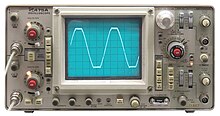Tektronix
The name was similar to that of a California company, Techrad, so in 1946, the four partners, Howard Vollum, Jack Murdock and Miles Tippery, who had both served in the Coast Guard, and accountant Glenn McDowell, formed Tektronix, Inc. Each contributed an initial $2,600 for equal shares.
Following the founding of Tektronix, Vollum invented the world's first triggered oscilloscope in 1946, a significant technological breakthrough.
[10] Murdock and Vollum were known humanitarians and sought to operate their business as one might run a large and caring family.
Later Tektronix added plug-ins to have the scope operate as a spectrum analyzer, waveform sampler, cable tester and transistor curve tracer.
It also brought the oscilloscope into the transistor age (only a Nuvistor ceramic tube was used for the vertical amp input).
Hughes Aircraft Company is credited with the first working storage oscilloscope (the model 104D) but it was made in very small numbers and is extremely rare today.
[citation needed] In 1974, the company acquired 256 acres (1.0 km2) in Wilsonville, Oregon where it built a facility for its imaging group.
[10] Tektronix's 1956 expansion and, in 1962, Electro Scientific Industries' similar move to Washington County and expansion are credited with fostering the development of a large high-tech industry in Washington County, a number of firms which collectively are often referred to as the "Silicon Forest".
[23] Beginning with the firm's first cathode ray oscilloscopes, Tektronix has enjoyed a leading position in the test and measurement market.
Later on, they built their own integrated circuit manufacturing facility in order to make custom ICs for their equipment.
As Tektronix fabricated more specialized parts, they spread out their product base to include logic analyzers, digital multimeters and signal generators.
The TM500 and TM5000 rack mount series was born featuring custom designed test instruments chosen by the buyer.
The 8560 emerged just after Bell Labs were able to sell UNIX commercially, and ran a mildly modified version of Version 7 UNIX, called TNIX, supporting 4 or 8 (depending on how many I/O processor cards were fitted) serial terminals, with a special High-Speed Input/Output, based on RS-422, to connect to a remote 8540.
There was a hard drive of about 34MB, later increased, and a variable amount of RAM depending on the processor card fitted, which was either a DEC LSI11-23+ or a LSI11-73, which had a wider address bus as well as a higher clock speed.
Thus a complete compile, link, load and emulate session could be run from a UNIX shell script, a facility probably not seen on any development system since.
The 8540/8550/8560 supported many 8-bit and 16-bit microprocessor types, with a change of emulator cards and probes, and installation of assembler and possibly compiler software, and did not require any particular code to be linked in to the user's code to facilitate register tracing at breakpoints, a shortcoming of the only real alternative multi-manufacturer MDS of that era, by HP.
This for example could allow UNIX to write variables to a log file as commanded by the running program on the emulated microprocessor.
It is not clear at present why Tektronix eventually withdrew from the MDS business, as their products were highly regarded.
In 1994, Tektronix spun off its printed circuit board manufacturing operation as a separate company, Merix Corp., headquartered in Forest Grove, Oregon.
Upon his promotion in 2000, the current CEO, Richard H. "Rick" Wills, carefully limited corporate spending in the face of the collapsing high-tech bubble.
This led the way for Tektronix to emerge as one of the largest companies in its product niche, with a market capitalization of $3 billion as of April 2006.
During this period Tektronix would also expand its test equipment line to logic analyzers, signal generators etc.
The 11000 series would be replaced by the MSO (Mixed Signal Oscilloscope) which featured a color active matrix LCD.
All TDS and spinoff series with LCD display are totally portable (light weight and can run AC or on batteries).
On October 15, 2007, Danaher Corporation tendered an offer to acquire Tektronix for $38 cash a share, which equated to a valuation of approximately $2.8 billion.
[26] The deal closed five and a half weeks later, with 90 percent of TEK shares being sold in the tender offer.
[30] Tektronix Video, commonly known for their waveform monitors, was merged with Telestream via an agreement with Fortive on April 25, 2019.





